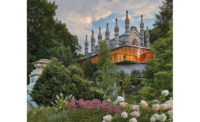Bishop Selwyn Chapel is a small yet significant addition to the Anglican Cathedral in Auckland, New Zealand. One of several church buildings situated on a prominent ridge, it sits alongside a finely detailed, gothic wood structure, St. Mary’s, that served as the principal Anglican church in New Zealand’s largest city from 1888 to 1973. On its north end, the chapel is attached to a monumental redbrick chancel, a major expansion dating to 1939. In the 1960s, another extension, signaled by a dramatically folded roof over a nave, was added. Then, in 2011, the diocese prepared a brief calling for a new space that could accommodate 100 people for worship, choral performances, and special events. Fearon Hay Architects, an Auckland-based firm, was selected as the architect for this latest addition, named for the first Anglican Bishop of New Zealand (from 1848–58), who was an important advocate for the rights of New Zealand’s indigenous people, the Maori.
Additional Content:
Jump to credits & specifications
The new chapel introduces a sense of calm to the eclectic collection of buildings. Fearon Hay conceived it as a single space located on axis with the cathedral and placed south of the main altar, so it can be entered through the older church’s flanking ambulatories. At the southern end, the chapel overlooks a garden, columbarium, and an expansive mountainous landscape beyond, including the spectacular volcanic peak of Maungakiekie. “We sought to complete and extend the journey from north to south . . . from the front of the cathedral to Auckland’s landscape,” says Jeff Fearon, director of Fearon Hay.
A gracefully curved roof that recalls a baldachin is the defining element of the chapel. This is no baroque device referring to the work of Bernini but rather a thin canopy that suggests a simple fabric to shelter the congregants gathering beneath it. Fearon Hay connected the light, billowing shape to the masonry wall of the cathedral with a narrow, glazed roof carried on structural glass beams. With this unobtrusive link, the lustrous Florentine gold leaf ceiling of the canopy, supported on tubular steel columns, appears to float above the chapel’s three precisely detailed glass walls, framed in bronze.
The pavilion’s refined lightness contrasts dramatically with the massive weight of the existing redbrick cathedral; its sumptuous palette is juxtaposed against the older buildings’ everyday materials. The collection of structures now assembled on this site not only traces a vivid history of architecture in New Zealand over the last century, but highlights changing priorities in ecclesiastical design. By alluding to an archetypal tentlike form, using rich materials, and opening to the horizon, Fearon Hay has created a new and inspiring space for worship in nature.
CreditsArchitect: Fearon Hay Architects
Personnel in architect's firm who should receive special credit: Jeff Fearon - Director
Associate architect(s): Michael Huh
Engineers Structural - Holmes Consulting Group Consultants Landscape - Jacky Bowring
General contractor: Aspec Construction
Photographer: Patrick Reynolds |
SpecificationsExterior Cladding Metal panels: Sheet metal cladding manufactured by Architectural Metalformers Precast concrete: Nauhria Roofing Metal: Copper sheet manufactured by Architectural Metalformers Tile/shingles: Ply ceiling carcass and tiles manufactured by Woodstar Other: Waterproof membrane Glazing Glass: Frameless glazing manufactured by Woods Glass Doors Sliding doors: Sliding glazed doors manufactured by Panoramah / L'Officina by Vincenzo Special doors: Glazed pivot doors manufactured by Woods Glass Upswinging doors, other: Wall louvres manufactured by Osbournes Hardware Other special hardware: Specialist hinges manufactured by Manfred Frank Interior Finishes Paints and stains: Gold Leaf ceiling by Studio Carolina Izzo Solid surfacing: The bell canopy manufactured by Sheetmetals Ltd Floor and wall tile: Stone tiles by European Ceramics and Stone Special interior finishes unique to this project: Floor grates manufactured by Lathamgrid Furnishings Chairs: Theo chair by Chorus Other furniture: Custom-made furniture by Neil Dawson Lighting Interior ambient lighting: Flos Energy Add any additional building components or special equipment that made a significant contribution to this project: The cross artwork by Neil Dawson
|











Post a comment to this article
Report Abusive Comment